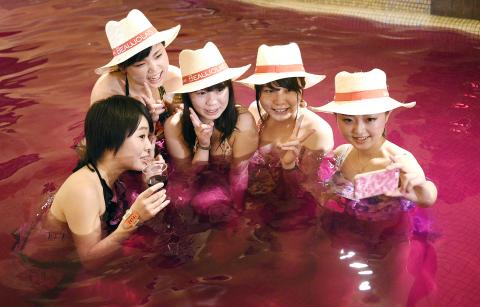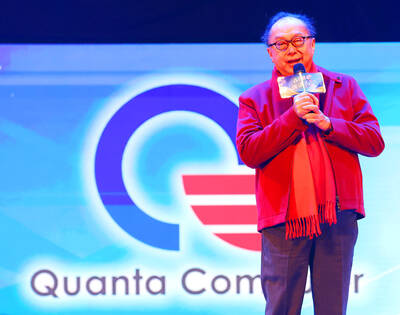More Japanese women than ever are heeding the call to enter the workforce as the population shrinks. They are not being rewarded with the same kinds of jobs and level of pay that men receive.
While the employment rate of women ages 15 to 64 has inched up to a record 65.4 percent (it is 82.3 percent for men), full-time female workers on average still earn about 30 percent less than males, according to the government data. The pay gap is the third-widest among members of the Organisation for Economic Co-operation and Development.
The issue is not so much that women with equal skills and experience are paid less than men who do the same job — Japan is making efforts to improve this — it is more about the kinds of roles and opportunities that are available to them.

Photo: EPA
A prime example is the swelling ranks of women in the health and welfare sectors, Akio Doteuchi from the NLI Research Institute in Tokyo said. Women are pouring in to meet demand in the nursing home industry, where wages are low, he says.
They are not finding the same opportunities for senior roles because of Japanese employment practices, according to Doteuchi. These make it difficult to balance work and family and typically require many years of service and long hours to reach management positions.
Japanese Prime Minister Shinzo Abe, who took office in late 2012, is trying to change this and has set a goal of women holding 30 percent of leadership positions in all areas of society by 2020. They held 12.3 percent of managerial jobs in the private sector last year, up from 10.6 percent in 2012, labor ministry data show.
Women account for 68 percent of workers in what Japan classifies as non-regular positions, which covers part-time, contract and temporary jobs. This helps explain the increase in women working in hotel and restaurant jobs, Doteuchi said.
Non-regular workers are paid 38 percent less on average than regular workers, government data show. They also have limited job security and fewer pension and insurance benefits.
Japan ranks 101st out of 145 countries in the World Economic Forum’s (WEF) global gender gap index released on Thursday.
The WEF study measures national gender gaps on economic criteria (workforce participation, remuneration and opportunity), political empowerment (ratio of men to women in senior government positions), education (literacy rates and schooling levels), and health and survival (life expectancy and sex ratios at birth). It is designed to be independent of how developed a country is.
The report said women today are being paid the average wage men earned almost a decade ago, and it will take 118 years before men and women earn equal pay at the current rate of convergence.
Some 250 million women have entered the workforce since 2006, according to the report released on Thursday.
“More women than men are enrolled in universities in nearly 100 countries, but women hold the majority of senior roles in only a handful of countries,” Saadia Zahidi, head of the Global Challenge on Gender Parity at the WEF, said in the statement. “Companies and governments need to implement new policies to prevent this continued loss of talent and instead leverage it for boosting growth and competitiveness.”
The top five countries by ranking are Iceland (No. 1 for a seventh consecutive year), Norway, Finland, Sweden and Ireland. The US dropped 8 places to 28th, as the percentage of women holding government ministerial positions declined to 26 percent from 32 percent; Yemen is the least equal country of the 145 nations in the report.
The UK’s global ranking rose to 18th from 26th last year, though it is down from 9th in 2006, the first year the WEF published the gender-gap report.
More than 80 percent of the countries examined made progress on labor force participation, with Nepal posting the largest increase, the report said. Countries with the strongest growth include Botswana, Nigeria, Spain, Nicaragua, South Africa and Lesotho.
The largest gains for women in senior political and managerial roles were in Colombia, Ghana and France.
Lesotho, Albania and Guatemala had the most improvement in high-skilled professional and technical roles, the report said.
The WEF is best known for its annual conference in Davos, Switzerland, which attracts heads of government and corporations to the Alpine resort every January. The WEF has backed the forum as a place to give women a voice.

Quanta Computer Inc (廣達) chairman Barry Lam (林百里) is expected to share his views about the artificial intelligence (AI) industry’s prospects during his speech at the company’s 37th anniversary ceremony, as AI servers have become a new growth engine for the equipment manufacturing service provider. Lam’s speech is much anticipated, as Quanta has risen as one of the world’s major AI server suppliers. The company reported a 30 percent year-on-year growth in consolidated revenue to NT$1.41 trillion (US$43.35 billion) last year, thanks to fast-growing demand for servers, especially those with AI capabilities. The company told investors in November last year that

Intel Corp has named Tasha Chuang (莊蓓瑜) to lead Intel Taiwan in a bid to reinforce relations between the company and its Taiwanese partners. The appointment of Chuang as general manager for Intel Taiwan takes effect on Thursday, the firm said in a statement yesterday. Chuang is to lead her team in Taiwan to pursue product development and sales growth in an effort to reinforce the company’s ties with its partners and clients, Intel said. Chuang was previously in charge of managing Intel’s ties with leading Taiwanese PC brand Asustek Computer Inc (華碩), which included helping Asustek strengthen its global businesses, the company

Taiwanese suppliers to Taiwan Semiconductor Manufacturing Co. (TSMC, 台積電) are expected to follow the contract chipmaker’s step to invest in the US, but their relocation may be seven to eight years away, Minister of Economic Affairs J.W. Kuo (郭智輝) said yesterday. When asked by opposition Chinese Nationalist Party (KMT) Legislator Niu Hsu-ting (牛煦庭) in the legislature about growing concerns that TSMC’s huge investments in the US will prompt its suppliers to follow suit, Kuo said based on the chipmaker’s current limited production volume, it is unlikely to lead its supply chain to go there for now. “Unless TSMC completes its planned six

TikTok abounds with viral videos accusing prestigious brands of secretly manufacturing luxury goods in China so they can be sold at cut prices. However, while these “revelations” are spurious, behind them lurks a well-oiled machine for selling counterfeit goods that is making the most of the confusion surrounding trade tariffs. Chinese content creators who portray themselves as workers or subcontractors in the luxury goods business claim that Beijing has lifted confidentiality clauses on local subcontractors as a way to respond to the huge hike in customs duties imposed on China by US President Donald Trump. They say this Chinese decision, of which Agence